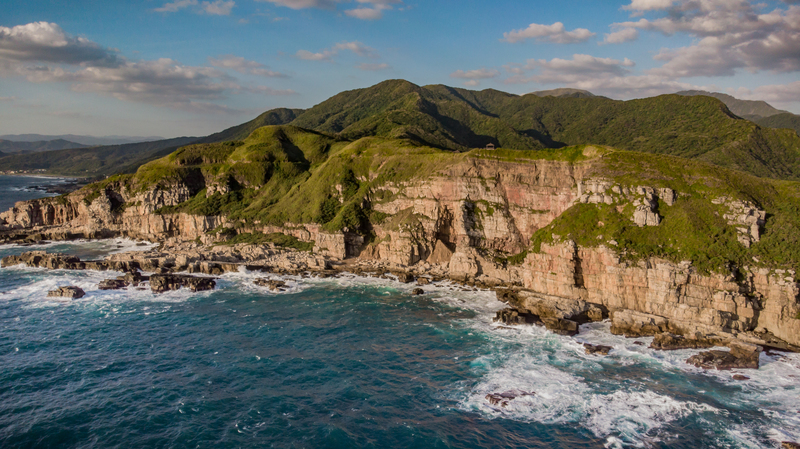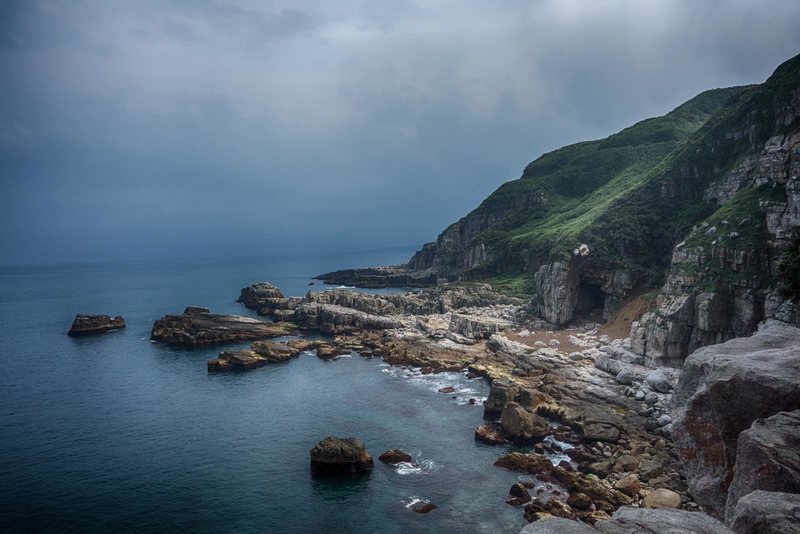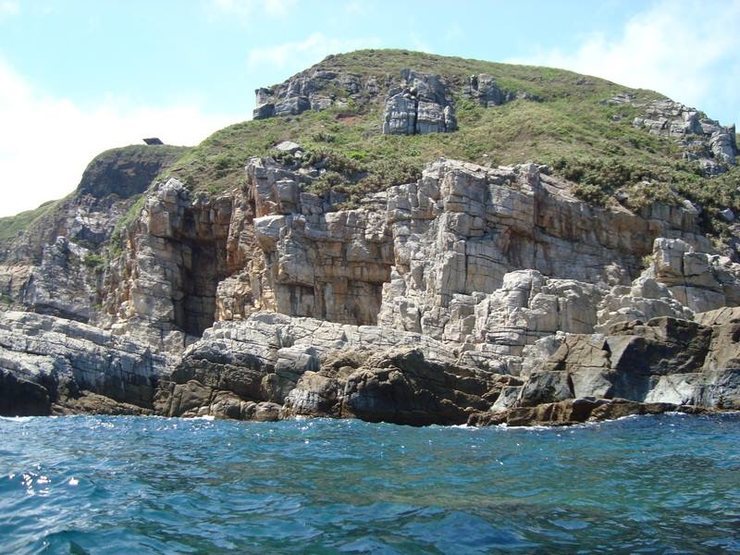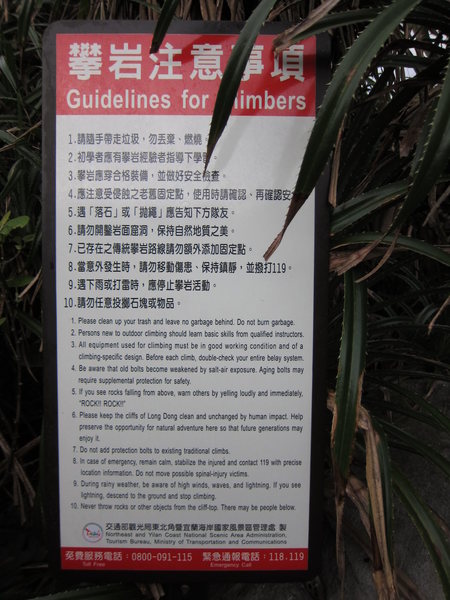
Lóng Dòng (龍洞 in traditional Mandarin) is a long stretch of sea cliffs on the northern end of Taiwan facing east into the Pacific Ocean. The name here sounds like a crude reference, but actually translates to Dragon Cave. It sits just north of the Tropic of Cancer, and is indeed a tropical paradise... though perhaps not the same one you had in mind.
Preface:
Several 3D composites of the major areas:
School Gate : Clocktower : Music Hall (L) and Long Lane (R) : Grand Auditorium : First Cave : Golden Valley
Matt's guidebook is beautiful. However, it is out-of-date due to several bolt failures caused by corrosion (see "Bolts" note below) as well as re(tro)bolting with 316-grade stainless steel and, more recently, titanium. Alternatively, you can download the MP app and view all of the information posted here at the crag. It could save you a lot of trouble.
If you do get the guidebook, there is a locally-sourced supplement to the guidebook called Guidebook Plus.
If you have any information to share about the routes you've climbed, please contact the editors of GB+ or message me personally.
Basics:
The character of the climbing is totally unique. The crashing waves, terraces of stone, and thorny pandanus plants all contribute to the exotic feel of this place. Although the Dragon Cave has a character all its own, it could be compared to the Gunks of New York State for its rock type and traditional style, and Clear Creek Canyon, Colorado for its rock coloration and sport style. Most of the cliffs are less than 30m tall, and the solid portions shorter still, but a few bigger, more adventurous climbs do exist. Many of the crags are separated by 5-10 minutes that involve a lot of boulder hopping, scrambling, and sometimes even traversing, which can be treacherous for the inexperienced adventurer.
Community:
The vast majority of climbers are locals, as the crag has not caught on as an international destination. However, expats and travelers are not uncommon. Weekends tend to be crowded in certain areas, though you can usually find a cliff all to yourself if you do not set your heart on one particular climb. Most people are very willing to help out, but it is advised that you seek partners before you arrive. As for non-climbers, the area is popular among fishermen, whom you will see standing out on the rocks in all kinds of weather. Divers and day-trippers are also common, especially in the summer, when they flood the north parking area day after day.
Geology:
The rock is erroneously referred to as "sandstone". It is in fact a quartz-rich metaconglomerate that comes in many shades, ranging from dull gray to orange, red, black, gold, and silver. There are large crystals and inclusions that bite on the fingers and shoes that keep the rock generally high friction. Some areas even have beautiful clusters of fully-formed quartz points as climbing features. Beware that the coarse and undulating stone, though dense and hard, may make placing trad gear complex.
Gear:
A dozen quickdraws for sport, a single rack to 3" for trad, and a 50-meter rope is fine for a vast majority of routes. However, a climber wanting to do everything should take a double set of cams from very small to 4", a set of nuts (offsets & micros), 15+ quick-draws, and several slings. A 60m rope is necessary for a very select few routes. Some cord/webbing and lockers can be handy for top-rope anchors and multi-pitch routes. And a helmet!
Also beware to clean your gear after every trip, as it may be fine the night after getting misted, but may not work at all after a month in your closet.
Style:
Routes are neatly differentiated as either sport or trad. Sport = fully bolted with lower-offs. Trad = no bolts except anchors of some variety. It is worth noting that most of the sport climbs can be, have been, and may have even been FA'd on trad gear. The grades run the entire spectrum of difficulty, centered around 5.10 and fairly honest until you reach 5.11, at which point the relative difficulty is all over the map.
Top anchors:
They're a bit of a hodge-podge. Routes with stainless steel anchors will have two level or staggered glue-in bolts with quick-links. Titanium anchors often have rams horns. Lowering is the recommended procedure for cleaning these routes. Sometimes there will be bare bolts that you must rap from. Some traditional climbs have rope-webbing-ring anchors that are solid as long as they aren't too sun-faded and crusty. Please do not remove any of the fixed hardware and never top-rope through it.
Local hazards:
Most routes currently have solid to semi-reliable hardware, but this is complicated by a failure mechanism specific to seaside crags. Check the "Bolts" note below. Some cliffs may be inaccessible depending on tide and weather. There have been regular occurrences of fishermen being swept out by rogue waves. Wasps like to build their hives under overhangs from July to September. You are likely to get buzzed if climbing during this time. Though stings are rare, the big orange ones (aka "murder hornets") can be deadly. If you see a hive, please report it and keep your distance.
Food:
Snacks and drinks may be purchased at the north parking area, but this is limited to instant noodles, canned bean congee, water, beer, and other cheap beverages. It is highly recommended that you pack your own food.
Regulation:
The climbing here is informally overseen by a local non-profit climbing organization. Although the cliffs are in a national scenic area, and efforts have been made in the past by the land management administration to enact some nonsensical rules, it currently remains joyfully regulation-free.
Go to the gyms and meet yourself a ride! The direct bus from Taipei is no longer in service - RIP. Now just follow whatever Google Maps recommends for your expected departure time. If arriving by bus, it's best to follow directions for the North Entrance.
There are three main parking areas: North, Central, and South. North is best for the School Gate, Clocktower, Long Lane, and Music Hall crags. Central is best for Grand Auditorium and the Caves. South is best for Golden Valley and Backdoor.
North: Just past the lighthouse at Bitou, you will pass through a tunnel. Long Dong Bay will appear on your left, and there will be signs in English. If driving, turn left at the intersection onto the road that circumnavigates the bay to the parking lot. If taking the bus, continue past this to the next stop (Lóng dòng gǎng) just up the hill. Cross the street and take the stairs down into the village and continue to the parking lot (5 mins). There is a bathroom here. Approach along the rocky shoreline and follow a trail into the pandanus plants, making for the obvious corner of School Gate crag.
Central: After the intersection, having come considerably up hill, you will encounter an unmarked turn-off on the left on a right hand curve. Follow the road to its end and park here. Walk up a white stone trail which takes you to some nice overlooks. If descending to Grand Auditorium, turn left into the trees, and continue to a stone wall with metal railing. Do not continue past this point if there is a peregrine falcon closure in place, usually Feb 1 - June 30. Otherwise, jump the railing and descend to the Grand Auditorium. From the gazebo, you can continue on the white stone trail to the muddy rut that descends to Golden Valley. This parking lot is not accessible by bus but you can walk up the stone trail behind the school from the north parking area.
South: Continue south and go through a tunnel. Just after the tunnel, take the first left into a small drive, passing a small Buddhist temple on your left and continue to the end of the short drive. There is a public toilet and washing sink. For Golden Valley, walk out the far end of the parking lot on the white stone trail for about 500m to the muddy rut of the fisherman's trail which leads downward. For Backdoor, walk down to the gazebo and then past it. Follow a fairly obvious trail that eventually takes you down some stone steps to the tiered platform. The bus does not have a marked stop here, but if you ask nicely in Chinese they will usually let you off just after the tunnel.
Return: Busses back to Keelung stop at the same spots you get off for the North and South entrances. Otherwise, hitchhike is always an option.
Check the route descriptions for info on bolt types. Under "Protection" it will be described as follows:
Dangerous - 304 glue-ins, expansions, 10+ years old
316 steel - Questionable, clip at your own risk
Titanium - Solid
Story of SCC:
There have been a few severe injuries and several near-misses as a result of bolt failures at Long Dong. In July 2015, both anchor bolts on a popular route failed simultaneously while a climber was top-roping. Thankfully they were not seriously hurt. The phenomenon that caused these failures is unique to seaside crags...
Basically, salt from the sea water is deposited by wind or spray onto the bolts. Steel, which comes in many different varieties, can be severely weakened by contact with the chlorides in the salt, which reacts with the internal stress from fabrication. This is called "stress corrosion cracking."
Mechanical bolts are far more susceptible to corrosion for various reasons. These are universally considered unreliable in marine environments and have been almost completely removed. Glue-ins, on the other hand, are stronger and more resistant, but they are still susceptible to SCC, and some more than others. There has yet to be a confirmed 316-grade stainless steel bolt failure, so their lifespan remains unknown. The local team has decided to leave them in place for the time being.
As the folks in Thailand and elsewhere have learned, titanium glue-in bolts are the only long-term solution. QX from the Bivy has been very proactive in acquiring bolts, installing them, and chopping the old ones, all on his own dime. The local team has also rebolted with a locally-produced titanium bolt, and are engaged in ongoing pull-testing of stainless bolts.
Climb safe.
The Bivy, home of the local gurus QX and Kelly, is the original climbers' home, located in the village of Bitou. It is a 5-minute drive or 30-minute walk from the north parking area. Find them on Facebook for prices and availability.
There are also rooms in a house owned by an old couple at the north parking area. It will have a #3 address plate by the door. The old lady who runs it, call her Ah-Ma, doesn't speak any English, but just be polite and she'll know what you want. It's 1200NT/night or 400NT/person if more than three people. They provide tatamis, blankets, pillows, and beds. Call 02-2490-9546.
There are also hostels in the beautiful tourist town of Jiufen, and established pay-site camping in the beach town of Fulong. Both are about a 20-minute drive from the north parking area.
Technically speaking, camping is not allowed at LD. There is a sign at the north parking area that says so clearly in Chinese and English. However, I have never heard of a story in which people who were camping were bothered. Maintain a low profile and clean up after yourself.
The climate here allows for climbing days to be had year-round, though it has a reputation for being temperamental. Keelung, a city to the north, receives an incredible amount of rain per year (140in/370cm). Though the Dragon Cave escapes the worst of it, it can still be unclimbable at times. The summer is dry (except typhoons) but uncomfortably hot. Spring and fall have regular wet streaks but are more often okay. Winter is soggy and cold but occasionally perfect.
Check the forecast from CWB here.












Matt and Maurice, awesome job! To the rest of the community, you are what make this place so fuggin spectacular! May 2, 2012
If anyone has any advice on what climbs in Taiwan are great for absolute beginners (or would like to invite me to go along on a climb) I'd love to hear about it! Aug 2, 2013
A few notes for potential visitors:
This place is very beginner friendly, for both sport and trad. Easy approaches, generally vertical terrain, good rock quality, excellent features for easy and solid placements, and many more bolts per route than you'll find stateside.
However, setting topropes is not as easy without having at least one lead-capable party member - top access is not possible for most areas and bolted anchors can be difficult to reach in areas where access is possible.
For more seasoned climbers, LD has lots to offer as well - much more than is listed on MP. There are many bolted lines in the 5.12 range, although notably fewer at 5.13 and above. Don't expect a hardman's mecca along the lines of the Red, New, Smith, Rifle, etc, but there are plenty of quality lines to keep all ability levels occupied for multiple seasons. Grading tends to be inflated by one or two letters on average, similar to numbers in China and Thailand.
The crags are generally not rain friendly, due to the mostly vertical nature of the cliffs. Cave areas suffer from humidity, slickness, and loose, sandy stone after storms. Exposed, south, and east facing walls dry quickly after rain, though.
The stores along the main entrance (He Mei elementary school) sell tropical fruit jellies when in season. This is critical beta during the spring and summer months.
Oh, and a super-quality guidebook is available in English. Oct 30, 2013
Orford, NH
Thanks! Aug 14, 2015
Is it still worth going? Or are too many of the bolts of questional integrity to make it safe?
Rebolting should begin soon. There has yet to be a verified failure of 316 stainless, and thus life expectancy exceeds 10 years. Read through this thread mountainproject.com/forum/t… if you wish to know more.
With just a little extra precaution, you will be fine. There are enough safe routes to keep any trad or sport climber occupied for months if not years.
See the link to Guidebook Plus at the top of this page. Aug 23, 2015
Sacramento, CA
Austin
Around Boulder, CO
If you disagreement is more general, then you can use the 'Your Difficulty Rating' tab under the 'You and This route' grey box to add to the consensus rating, which is what is displayed.
If you hit the '_ Opinions' text there you can see what has gone into it to date.
For the record, I don't find LD sandbagged at all. Though I was a foreigner there, I found myself flashing at my limit (or above) on some hard routes & not particularly tested by easier ones. Jan 5, 2020
Grade creep is a thing, largely bred by climbing gyms (Planet Granite is an egregious local example) that want to give climbers the feeling of accomplishment without actually tying it to the outdoor reality. That's why older areas - Yosemite, Smith Rock, El Dorado, etc - tend to have "sandbagged" grades. These places remain immune to grade creep because of their classic status, while newer areas tend to get softer and softer.
In the end, it's just a grade, which shouldn't matter. Try hard, send or not, just let yourself enjoy being on rock outside. Jan 6, 2020